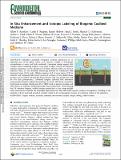| dc.contributor.author | Barnhart, Elliott P | |
| dc.contributor.author | Ruppert, Leslie F | |
| dc.contributor.author | Hiebert, Randy | |
| dc.contributor.author | Smith, Heidi J | |
| dc.contributor.author | Schweitzer, Hannah D | |
| dc.contributor.author | Clark, Arthur C | |
| dc.contributor.author | Weeks, Edwin P | |
| dc.contributor.author | Orem, William H | |
| dc.contributor.author | Varonka, Matthew S | |
| dc.contributor.author | Platt, George | |
| dc.contributor.author | Shelton, Jenna L | |
| dc.contributor.author | Davis, Katherine J | |
| dc.contributor.author | Hyatt, Robert J | |
| dc.contributor.author | McIntosh, Jennifer C | |
| dc.contributor.author | Ashley, Kilian | |
| dc.contributor.author | Ono, Shuhei | |
| dc.contributor.author | Martini, Anna M | |
| dc.contributor.author | Hackley, Keith C | |
| dc.contributor.author | Gerlach, Robin | |
| dc.contributor.author | Spangler, Lee | |
| dc.contributor.author | Phillips, Adrienne J | |
| dc.contributor.author | Barry, Mark | |
| dc.contributor.author | Cunningham, Alfred B | |
| dc.contributor.author | Fields, Matthew W | |
| dc.date.accessioned | 2023-02-22T17:23:34Z | |
| dc.date.available | 2023-02-22T17:23:34Z | |
| dc.date.issued | 2022 | |
| dc.identifier.uri | https://hdl.handle.net/1721.1/148147 | |
| dc.description.abstract | Subsurface microbial (biogenic) methane production is an important part of the global carbon cycle that has resulted in natural gas accumulations in many coal beds worldwide. Laboratory studies suggest that complex carbon-containing nutrients (e.g., yeast or algae extract) can stimulate methane production, yet the effectiveness of these nutrients within coal beds is unknown. Here, we use downhole monitoring methods in combination with deuterated water (D2O) and a 200-liter injection of 0.1% yeast extract (YE) to stimulate and isotopically label newly generated methane. A total dissolved gas pressure sensor enabled real-time gas measurements (641 days preinjection and for 478 days postinjection). Downhole samples, collected with subsurface environmental samplers, indicate that methane increased 132% above preinjection levels based on isotopic labeling from D2O, 108% based on pressure readings, and 183% based on methane measurements 266 days postinjection. Demonstrating that YE enhances biogenic coalbed methane production in situ using multiple novel measurement methods has immediate implications for other field-scale biogenic methane investigations, including in situ methods to detect and track microbial activities related to the methanogenic turnover of recalcitrant carbon in the subsurface. | en_US |
| dc.language.iso | en | |
| dc.publisher | American Chemical Society (ACS) | en_US |
| dc.relation.isversionof | 10.1021/ACS.EST.1C05979 | en_US |
| dc.rights | Creative Commons Attribution-NonCommercial-NoDerivs License | en_US |
| dc.rights.uri | http://creativecommons.org/licenses/by-nc-nd/4.0/ | en_US |
| dc.source | ACS | en_US |
| dc.title | In Situ Enhancement and Isotopic Labeling of Biogenic Coalbed Methane | en_US |
| dc.type | Article | en_US |
| dc.identifier.citation | Barnhart, Elliott P, Ruppert, Leslie F, Hiebert, Randy, Smith, Heidi J, Schweitzer, Hannah D et al. 2022. "In Situ Enhancement and Isotopic Labeling of Biogenic Coalbed Methane." Environmental Science and Technology, 56 (5). | |
| dc.contributor.department | Massachusetts Institute of Technology. Department of Earth, Atmospheric, and Planetary Sciences | en_US |
| dc.relation.journal | Environmental Science and Technology | en_US |
| dc.eprint.version | Final published version | en_US |
| dc.type.uri | http://purl.org/eprint/type/JournalArticle | en_US |
| eprint.status | http://purl.org/eprint/status/PeerReviewed | en_US |
| dc.date.updated | 2023-02-22T16:41:27Z | |
| dspace.orderedauthors | Barnhart, EP; Ruppert, LF; Hiebert, R; Smith, HJ; Schweitzer, HD; Clark, AC; Weeks, EP; Orem, WH; Varonka, MS; Platt, G; Shelton, JL; Davis, KJ; Hyatt, RJ; McIntosh, JC; Ashley, K; Ono, S; Martini, AM; Hackley, KC; Gerlach, R; Spangler, L; Phillips, AJ; Barry, M; Cunningham, AB; Fields, MW | en_US |
| dspace.date.submission | 2023-02-22T16:41:35Z | |
| mit.journal.volume | 56 | en_US |
| mit.journal.issue | 5 | en_US |
| mit.license | PUBLISHER_CC | |
| mit.metadata.status | Authority Work and Publication Information Needed | en_US |
